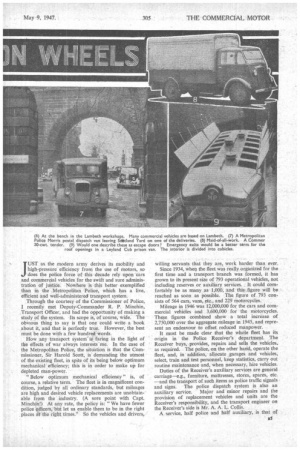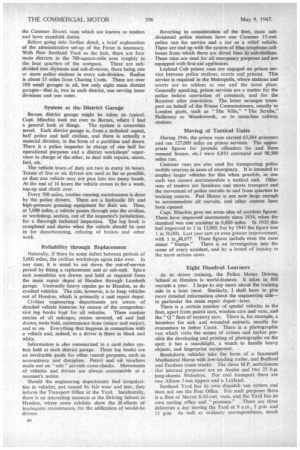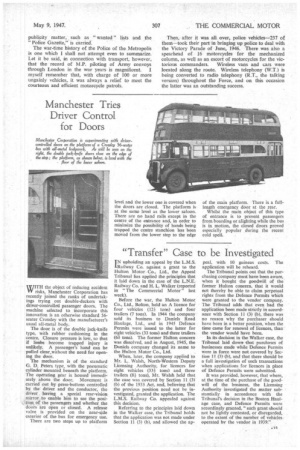J UST as the modern army derives its mobility and high-pressure
Page 39

Page 40

Page 43

If you've noticed an error in this article please click here to report it so we can fix it.
efficiency from the use of motors, so does the police force of this decade rely upon cars and commercial vehicles for the swift and sure administration of justice. Nowhere is this better exemplified than in the Metropolitan Police, which has a live, efficient and well-administered transport system.
Through the courtesy of the Commissioner of Police, I recently met Deputy-Commander R. P. Minchin, Transport Officer, and had the opportunity of making a study of the system. Its scope is, of course, wide. The obvious thing to say is that one could write a book about it, and that is perfectly true. However, the best must be done with a few hundred words.
How any transport system.is, faring in the light of the effects of war always interests -me. In the case of the Metropolitan Police, the situation is that the Commissioner, Sir Harold Scott, is demanding the utmost of the existing fleet, in spite of its being below optimum mechanical efficiency; this is in order to make up for depleted man-power.
"Below optimum mechanical efficiency!' is, of course, a relative term. The fleet is in magnificent condition, judged by all ordinary standards, but mileages are high and desired vehicle replacements are unobtainable from the industry. (A sore point with Capt. Minchin!) At any rate, the policy is: "We have fewer police officers, but let us enable them to be in the right places it the right times." So the vehicles and drivers, willing servants that they are, work harder than ever.
Since 1934, whep the fleet was really organized for the first time and a transport branch was formed, it has grown to its present size of 793 operational vehicles, not including reserves or auxiliary services. It could comfortably be as many as 1,000, and this figure will be reached as soon as possible. The figure of 793 consists of 564 cars, vans, etc., and 229 motorcycles.
Mileage in 1946 was 12,000,000 for the cars and commercial vehicles and 3,600,000 for the motorcycles. These figures combined show a total increase of 2,750,000 over the aggregate mileage in 1945, and represent an endeavour to offset reduced manpower.
It must be made clear that the whole fleet has its origin in the Police Receiver's department. The Receiver buys, provides, repairs and sells the vehicles, as required. The police, on the other hand, operate the fleet, and, in addition, allocate garages and vehicles, select, train and test personnel, keep statistics, carry out routine maintenance and, when necessary, hire vehicles.
Duties of the Receiver's auxiliary services are general carriage—e.g., furniture, mattresses, stores, spares, etc. —and the transport of such items as police traffic signals and signs. The police dispatch system is also an auxiliary service. Major and minor repairs and the provision of replacement vehicles and units are the Receiver's responsibility, and the transport engineer on the Receiver's side is Mr. A. A. L. Collis.
A service, half police and half auxiliary, is that of
the Commer 30-cwt. vans which are known as tenders and have manifold duties.
Before going into further detail, a brief explanation of the administrative set-up of the force is necessary. With New Scotland. Yard as the hub, there are four main districts in the 700-square-mile area roughly in
the four quarters of the compass. These are subdivided into divisions and sub-divisions, there being one or more police stations in every sub-division. Radius is about 15 miles from Charing Crag's. There are over 100 small garages in all, but only eight main district garages—that is, two in each district, one serving inner divisions and one outer.
System at the District Garage
Barnes district garage might be taken as typical. Capt. Minchin took me over to Barnes, where I had a general look at things. The system is somewhat novel. Each district garage is, from a technical aspect, half police and half civilian, and there is actually a material division, in the form of a partition and doors. There is a police inspector in charge of one half for operational purposes and a district workshops' supervisor in charge of the other, to deal with repairs, stores, fuel, etc.
The vehicle tours of duty. are two in every 16 hours. Teams of five or six drivers are used. as far as possible, so that one vehicle may not pass into too many hands. At the end of 16 hours the vehicle comes in for a wash, top-up and cheek over.
Every 500 miles, routine running maintenance is done by the police drivers. There are a hydraulic lift and high-pressure greasing equipment for their use. Then, at 5,000 miles, a vehicle passes through into the civilian, or workshop, section, out of the inspector's jurisdiction, for a thorough technical inspection. The log book is completed and shows when the vehicle should be sent in for decarbonizing, refacing of brakes and other work.
Reliability through Replacement
Naturally, if there be some defect between periods of 5,000 miles, the civilian workshops again take over. In any case, it is usual to cut down the out-of-service period by fitting a replacement unit or sub-unit. Spare unit assemblies are drawn and held as required from the main repair depot at Hendon through Lambeth garage. Unusually heavy repairs go to Hendon, as do crashed vehicles. The aim, however, is to keep vehicles out of Hendon, which is primarily a unit repair depot.
Civilian engineering departments are aware of detailed vehicle histories by reason of the comprehen sive" log books kept for all vehicles. These contain entries of all mileages, routes covered, oil and fuel drawn, tools held, maintenance done (minor and major), and so on. Everything that happens in connection with a vehicle and, indeed, to a driver is there in black and white.
Information is also summarized in a card index systern held at each district garage. These log books are an invaluable guide for other record purposes, such as accountancy and discipline. Petrol and oil vouchers made out on "sale" provide cross-checks. Movements of vehicles and drivers are always accountable at a moment's notice.
Should the engineering departments find irregularities in vehicles, not caused by fair wear and tear, they inform the Transport Office at the Yard. Incidentally, there is an interesting museum at the Driving School at Hendon, where some exhibits show the ill-effects of inadequate maintenance, for the edification of would-be drivers.
Reverting to consideration of the fleet, most subdivisional police stations have one Cornmer 15-ewt. police van for service and a car as a relief vehicle. These are tied up with the system of blue telephone callboxes from which there are direct lines to sub-stations. These vans are used for all emergency purposes and are equipped with first-aid appliances.
Leyland Cub prison vans are engaged on prison service between police stations, courts and prisons. This service is required in the Metropolis, where stations and courts are so seldom at one and the same place. Generally speaking, prison services are a matter for the police before conviction of criminals, and for the Receiver after conviction. The latter arranges transport on behalf of the Prison Commissioners, usually to London gaols, such as "The Ville," "The Scrubs," Holloway or Wandsworth, or to main-line railway stations.
Moving of Tactical Units
During 1946, the prison vans carried 63,364 prisoners and ran 127,000 miles on prison services. The appropriate figures for juvenile offenders (to and from remand homes, etc.) were 8,933 conveyed and 98,500 mites run.
Cornmer vans are also used for transporting police mobile reserves in cases of emergency. It is intended to employ larger vehicles for this when possible, as one such van cannot accommodate a tactical unit. Other uses of tenders are furniture and stores transport and the movement of police recruits to and from quarters to training centres. Peel House is not now large enough to accommodate all recruits, and other centres have been opened.
Capt. Minchin gave me some idea of accident figures These have improved enormously since 1934, when the standard was one accident in 8,800 miles. In 1935 this had improved to 1 in 13,000, but by 1945 the figure was 1 in 38,000, Last year saw an even greater improvement, with 1 in 48,677. These figures include even the most minor bumps." There is an investigation into the cause of every accident, and by a board of inquiry in the more serious cases.
Eight Hundred Learners
As to driver training, the Police Motor Driving School at Hendon is world-fatnous. It takes in 800 recruits a year. I hope to say more about the training side in a later issue. Similarly, I shall have to give more detailed information about the engineering side— in particular the main repair depot—later. There is a certain number of special vehicles in the fleet, apart from patrol cars, wireless ears and vans, and the" Q" fleet of mystery cars. There is, for example, a horsebox for sick and wounded animals, usually for evacuation to Imber Court. There is a photographic van which visits the scenes of crimes and makes possible the developing and printing of photographs on the spot; it has a searchlight, a winch to handle heavy objects, and fingerprint equipment. Breakdown vehicles take the form of a Scarnmell Mechanical Horse with low-loading trailer, and Bedford and Fordson crane trucks. The three M.P. ambulances (for internal purposes) are an Austin and two 25 h,p. long-chassis Wolseleys. For coal transport there are two Albion 5-ton tippers and a Leyland.
Scotland Yard has its own dispatch van system and does not use the Post Office. For such purposes there is a fleet of Morris 8-10-cwt. vans, and the Yard has its own sorting office and "postmen." There are three deliveries a day leaving the Yard at 9 a.m., 2 p.m. and 11 p.m. As well as ordinary correspondence, much publicity matter, such as " wanted " lists and the "Police Gazette," is carried.
The war-time history of the Police of the Metropolis is one which I shall not attempt even to summarize. Let it be said, in connection with transport, however, that the record of M.P. piloting of Army convoys through London in the war years is magnificent. I myself remember that, with charge of 100 or more ungainly vehicles, it was always a relief to meet the courteous and efficient motorcycle patrols. Then, after it was all over, police vehicles-237 of them—took their part in bringing up police to deal with the Victory Parade of June, 1946. There was also a spearhead of 16 motorcycles for the mechanized column, as well as an escort of motorcycles for the victorious commanders. Wireless vans and cars were located along the route. Wireless telephony (W.T ) is being converted to radio telephony (RT., the talking version) throughout the Force, and on this occasion the latter was an outstanding success.












































































